
: : : Drumset : : Instruments : the stands
The stands
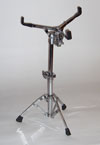
The "stand" is one of the first inventions associated with modern drum set. He appeared in the nineteenth century thanks to Hector Berlioz, revolutionary composer, conductor and percussionist which integrated for the first time all the instruments of military percussion in a symphony orchestra with a very "sound effects" approach ("Symphonie fantastique" 1830).
The first created in this place was the snare drum stand to allow the orchestra percussionist to go without difficulty from one instrument to another (to timpani or to cymbals with straps, for example). Today, a snare stand consists of two telescopic tubes and a side screw for height adjustment, rotary notched adjustment (foolproof) for orientation (very important for ergonomics) a tripod (with double (stronger) or single brace) with rubber tips (non-skid) and a basket with adjustable screw and rubber tips again, to tighten all sizes of snare, without damaging or create noise.
The suspended cymbal stand appears only in 1936 (Slingerland brand for Gene Krupa again!) with the golden age of "swing" jazz style and the emergence of "Big Bands" (the first modern drummers like Warren "Baby" Dodds , suspended cymbal to bar "L" ("bracket" attached to the bass drum and marketed a time) with the original strap and for long the cymbal was just screwed in an "arm" (rod curved or not) fixed on the bass drum).

The hi-hat pedal, which is actually also a stand, was created in the 1920s with the "sock cymbal" ("sock cymbal") lower, but will see its final high version for the joint play of the hands and feet in the 1930s as well (it is described in the chapter about hi-hat cymbals and the one about hi-hat pedal).
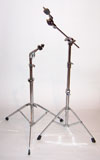
More recent models of cymbal stands are equipped with a "boom" (horizontal bar adjustable in all directions, to compensate the bulk of the tripod on the ground).
More lately appears the double braced tripod (for any type of stands) for greater strength and stability.
All stands have plastic tips in rubber, to adhere to the ground and not to damage it, and a retractable tripod for transport.
Note that a tripod shall make an angle of 45 ° with the ground, for an optimal distribution of the forces, bulk on the ground and stability.
The "rack" is the most recent invention. Variant of the stand, it proposes to replace the individual tripod (one per instrument) by setting at least four vertical legs connected by horizontal tubes on which can be fixed tom holders, "L" rods for cowbells or extension tubes and booms ("arms") for cymbals (Horacio "El Negro" Hernandez , for example, often uses this type of configuration, for its extended set). The downside is having an implantation more "rigid" (predetermined) of instruments, the advantage is to have fewer legs on the ground, which can interfere with each other and are not necessarily aesthetically pleasing and most important, marked locations ( "clamps" of extensions bolted to the rack) on the opposite of the stands for each individual instrument placed on the ground.
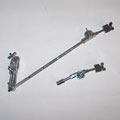
The "boom extension" is a tube with cymbal boom, attachable to a cymbal stand, a rack, or any other tube through a "clamp" (see "fasteners"). There are also extensions of cymbal stands fixable in the extension of the head (at the screw) to align two cymbals, one above the other (it is advisable to put a smaller cymbal on top, not to interfere with the play of the lower one).
All these systems have the advantage of reducing the bulk of the legs on the ground, but allow less freedom in the installation of the kit. This is why many drummers have today not adopted them (for my part, I am using only two boom extensions for two "splashes"). Notice also that you can save also a cymbal stand and place on the set by positioning a small splash down on a larger cymbal by adding a felt washer between the two (this is what Dave Weckl and Jack de Johnette make since several years, for example, as well as myself).
The snare stand has seen various changes to move towards consolidation and greater adjustability. Today, a good snare stand must allow to put the snare in all directions (vertical and horizontal independent rotation or ball joint) allow varied height adjustment (with two telescopic tubes and a robust screw) a retractable tripod (for easy transport) not too large (to avoid clutter on the floor, near the pedals), and have a screw basket (3 bars with hooks with rubber tips) to maintain snare, whatever its diameter.
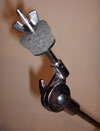
Cymbal stands are always tubular and telescopic (with one or two extensions) to adjust the height and allow them to be retracted for transport. They are provided at the ends with a steel washer, topped with a thick felt washer to allow the cymbal to be putted without noise and damage and "float" freely. A screw is passed through the system (whose orientation is adjustable by a notched rotation axis and screwed by a wing nut), on which the washers quote above are skewered, then the cymbal and another felt washer (or even a second steel washer) and finally all tightened by a wing nut. I don't recommend 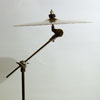 to screw this nut completely, to allow the cymbal to vibrate and move freely, thereby improving its resonance and durability. Some stand models are equipped with a tubular plastic "stop" around the screw approximately one inch long, which is practical to avoid an undesired clamping excess while avoiding unscrewing (or even fall) of the nut.
to screw this nut completely, to allow the cymbal to vibrate and move freely, thereby improving its resonance and durability. Some stand models are equipped with a tubular plastic "stop" around the screw approximately one inch long, which is practical to avoid an undesired clamping excess while avoiding unscrewing (or even fall) of the nut.
The setting of this "head" of the stand ("tilter") should be with a system with "notches", otherwise, be assured that your cymbal will go upset with several stick strokes (all recent quality models has one).
Finally, some superior quality booms have a counterweight on the opposite of the head, or a telescopic extension and /or "memory lock" (see "fasteners").
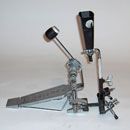
A final type of stand has emerged recently, which allows to adapt a cowbell or any small instrument (tambourine, jam-block, etc.) to a bass drum pedal to play with the foot (usually it is placed to the left of hi-hat). It is also called "foot pedal bracket". Already used by Tito Puente to play the rhythm of the "clave" in independence, Akira Jimbo , Robby Ameen and Horacio "El Negro" Hernandez , have popularized and "pushed up" its use in the 1990s.
It is constitued with a telescopic "L" rod for hanging the instrument into vertical position, a base to attach the pedal and two "mini legs" like those of a bass drum, to prevent the pullback, "recoil" (but I who actually use that for 13 years advise you to place it against one leg of the hi-hat stand, for more security).
Horacio "El Negro" Hernandez , Vince Cherico and Robby Ameen use it with a cowbell, Terry Bozzio and Marco Minnemann use it with a tambourine and Akira Jimbo with a "jam block".
This instrument is in my opinion one of the best recent innovations of the drumset, to bring into a diversification of playing techniques. It allows finally the left foot to move on different pedals to play a variety of different instruments, a bit like the hands, instead of confining to hi-hat, and allows a variety of timbres improving the polyrhythmical readability for the independence playing (it is understandable that play independently with only the feet, with a double bass drum pedal, means nothing on the sound aspect). In addition, this variety of timbres allows new imitations and adaptations of traditional polyrhythms, which constitute one of the main compositional principle  of modern drumset (imitation of batucada, in samba, a group of Cuban percussionists in Latin- jazz, etc.). Listen to a demonstration of the left foot clave independence with this stand, in my audio solo from 2004 or my video solo from 2016.
of modern drumset (imitation of batucada, in samba, a group of Cuban percussionists in Latin- jazz, etc.). Listen to a demonstration of the left foot clave independence with this stand, in my audio solo from 2004 or my video solo from 2016.
© 2005 Marc de Douvan Crédits Mentions légales
